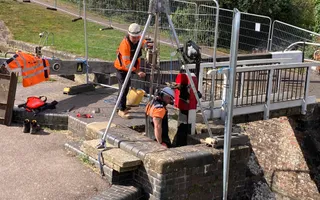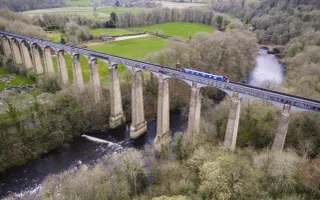Rising to the occasion in West Yorkshire
Recently, our quick-thinking staff and volunteers sprang into action to help save the life of cyclist Joost Smeele, after he suffered a cardiac arrest near Bingley’s famous Five Rise Locks.
The charity making life better by water
Making life better by water
Hot off the press, it’s our latest Regional Round Up, with all the news from a canal near you. This time, we’re going behind the scenes at some iconic sites and catching up with a few essential works.
Recently, our quick-thinking staff and volunteers sprang into action to help save the life of cyclist Joost Smeele, after he suffered a cardiac arrest near Bingley’s famous Five Rise Locks.
The incident occurred when 61-year-old Bingley-born resident, Joost, collapsed while cycling on Beck Lane, near the historic locks on the Leeds & Liverpool Canal. Our brave staff and volunteers were among the first on the scene, providing first aid and crowd control.
With emergency services on the way, volunteer lock keeper Richard Breese performed CPR, while owner of Five Rise Locks Café, Megan Darley, retrieved an automated external defibrillator (AED), using it to try and resuscitate Joost while they waited for the paramedics.
A major construction project at Toddbrook Reservoir in Whaley Bridge in Derbyshire is nearing its conclusion, with a new dam overflow spillway expected to be completed by Christmas. In September, we invited visitors along for a sneak peek at our progress across two public open days.
The three-year project is vital to getting the reservoir up and running again after the previous dam wall was damaged in 2019, following excessive rainfall.
Over the two days, visitors got their first glimpse of the new structure, as our contractor, Kier, puts the final touches to the new waterside weir, tumble bay, stepped spillway and stilling basin, which will provide a new route for excess water to reach the River Goyt. During the summer, they also removed some 460 bags of aggregate, dropped by RAF Chinook helicopters to shore up the dam wall after it was damaged in the storm.
Early next year, work will begin on a replacement sailing club and children’s playground. Artwork will be applied to the new concrete turrets and the local park re-landscaped with new trees, footpaths, and wildlife habitats.
“Once the work is finished, the reservoir will again be capable of performing its vital role of supplying water to the Macclesfield and Peak Forest canals,” says project manager Dilwyn Parry. “It will be restocked with fish, and hopefully by the summer, it will be fully restored as a community resource for sailing, angling and swimming.”
This summer, we took advantage of the unprecedented dry weather to carry out vital repairs at Foxton Locks in Leicestershire – the longest, steepest flight of staircase locks in the country.
Foxton Locks, on the Grand Union Canal, is one of the most breathtaking sights on our network, carrying more than 5,000 boats a year up and down a steep 75-foot incline, surrounded by 34 acres of rolling countryside.
This summer, with temperatures soaring and the locks temporarily closed to traffic due to drought, we brought forward essential repairs with a view to minimising disruption for boaters and local businesses.
The works involved replacing some of the paddles that regulate water levels in the lock chambers. The paddles, at locks 10 and 17, open and close to release water from special side ponds to improve the flow as boats make their way through the flight.
In addition to the paddle works, we also repointed historic brickwork within the 200-year-old flight of locks, filling in gaps in the canal wall with grout to prevent leaks.
One of the hottest, driest summers on record has taken a heavy toll on our ageing network, with wooden structures shrinking and swelling, bricks cracking, and reservoirs dwindling. The difficult decision to temporarily close Foxton Locks helped to save water to keep boats afloat, protected local wildlife, and safeguarded our precious infrastructure.
Last Edited: 24 October 2025

Sign up to our newsletter and discover how we protect canals and help nature thrive



